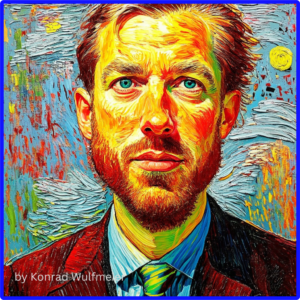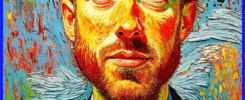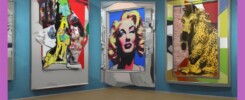Turn On – Feeling Art Anew, Seeing Anew, Becoming Anew
In a world overstimulated visually and emotionally dulled, art might be one of the last sanctuaries of true experience. But how often do we really look? How often do we let art enter us not just through the eyes, but through the heart and body? This article is an invitation: to feel art anew, to see it anew — and to awaken to oneself anew.
What happens when we stop treating art as a commodity and start seeing it as a mirror, an impulse, a portal? How does perception change when we not only look at art but feel it, penetrate it, allow it? This is a journey into depth — a path to new becoming.
1. Visually Saturated, Internally Hungry
Our world is full of images. We see thousands every day — on screens, billboards, social media. But the more we see, the less deeply we seem to look. The gaze becomes shallow, seeing turns into habit. We scroll, skim, swipe. Art becomes content.
to look. The gaze becomes shallow, seeing turns into habit. We scroll, skim, swipe. Art becomes content.
Yet deep within us remains a longing: for touch, for truth, for authenticity. We sense that art is capable of more — if we let it. It can pull us from speed, silence the noise, bring us back to presence.
To feel art means to pause. To slow the gaze. To bring the body along. To sense what happens when a work doesn’t just speak to us, but passes through us.
2. Sensual Seeing: Eyes, Skin, Breath
True seeing is a sensual act. It doesn’t start in the mind but in the senses — in the eyes, the skin, the breath. A painting can carry color but also temperature. It can radiate cold or heat, spaciousness or compression, calm or unrest.
When we reopen our senses, art comes alive. Then a brushstroke is not just technique, but a trace of gesture. A shadow isn’t just composition, but emotion. Light becomes presence. Texture begins to speak.
Skin can see. The body knows where truth lives. And sometimes, the feeling comes before the mind can name what’s happening.
3. Becoming Within: When Art Arrives Inside
The moment of becoming within is quiet. It’s not an explosion, not an explanation — but an internal echo. Something inside responds. Sometimes we don’t know why. A work evokes memory, longing, an unnamed sensation.
Becoming within isn’t analytical. It’s like inhaling a meaning that can’t be put into words. A piece that truly reaches us subtly but deeply alters our interior.
In my work with QuantumNature Art, I seek to shape this threshold: the image as a space of resonance. The digital realm is not an obstacle, but a medium — when we fill it with depth.
4. Beyond Interpretation: Experiencing, Not Explaining
Our culture loves concepts. We want to know what something means. We interpret, analyze, categorize. Even in art. But sometimes this craving for understanding blocks the experience.
What if we didn’t try to understand art, but instead allowed it? If for a moment we dropped the question of meaning — and instead listened, felt, followed?
Not all works must be explained. Some simply want to resonate. And perhaps therein lies their greatest power: in what they touch wordlessly.
5. Feeling the New: The Inner Switch
„Turn on“ is a shift. Something lights up — not outwardly, but inwardly. It’s the moment we stop merely „viewing“ and start being present.
Art can catalyze this transformation. It calls us back to ourselves. It shows what’s alive — in the world and in us. And sometimes it shows what’s missing: feeling, closeness, meaning.
In the touch of true art, borne of soul — analog or digital — we don’t shrink, we expand. We become more aware. More permeable. More fully ourselves.
6. Digital Depth: Can Screens Touch Us?
„Digital art doesn’t move me“ — a sentiment often heard. But is it truly the medium’s fault? Or how we engage with it?
The screen can be cold glass — or a portal to other dimensions. What matters is not the medium, but the intention, presence, and design. A digitally created work can carry as much depth as oil on canvas — if made with depth.
In my practice, I ask: How can we make depth visible? How does the invisible become tangible? How can art connect digital frequencies with analog sensation?
The answer lies in a willingness to slow down — and in trusting that the unseen also speaks.
7. Art as Mirror and Amplifier of the Inner World
Truly great art doesn’t just show us something new — it reveals something of ourselves we had overlooked. It is mirror, canvas, amplifier.
If we remain open, art becomes a space of self-encounter. A place where we meet ourselves — in beauty, in sorrow, in wonder. Not because the piece „knows us“, but because we find ourselves in it.
To see something new doesn’t mean discovering the unfamiliar — but rather experiencing the familiar in a new way. Perhaps, for the first time, with a true gaze.
8. Conclusion: The Call for Depth in a Fast World
In a world growing ever faster, we need sanctuaries of slowness. Places where we are allowed to feel again. Art can be such a place — if we let it be more than decoration.
„Turn on“ is more than an impulse. It is a mindset: Wake up. Feel. Allow yourself to be moved — and perhaps transformed. Art is not a product to be „used“. It is a field, a path, an inner motion.
To see art anew is to see ourselves anew. And to feel art anew is to reconnect — with the world, the moment, and our own soul.
© 2025 Konrad Wulfmeier | Master Code™ – QuantumNature-Art

